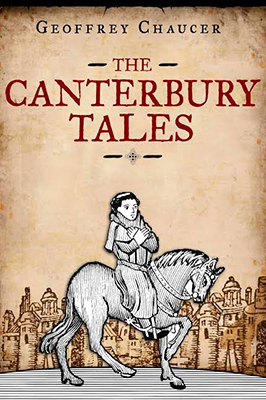Introduction
The Canterbury Tales Sumamary By Geoffrey Chaucer “The Canterbury Tales,” written by Geoffrey Chaucer in the late 14th century, is a seminal work of English literature that offers a vivid portrayal of medieval society. This collection of stories, presented as part of a narrative frame, features a diverse cast of characters from various social classes, each sharing their tales while on a pilgrimage to the shrine of Thomas Becket in Canterbury. Chaucer’s work is celebrated not only for its storytelling but also for its rich characterizations, exploration of themes such as love, morality, and social class, and its commentary on the human condition.The Canterbury Tales Sumamary By Geoffrey Chaucer
This summary provides an overview of “The Canterbury Tales,” examining its structure, key characters, major themes, and literary significance, while also addressing important questions related to the text.
Structure of “The Canterbury Tales”
“The Canterbury Tales” is structured as a frame narrative, where the overarching story is the pilgrimage itself. The tales are told by a group of 29 pilgrims, each representing different segments of medieval society, including the nobility, clergy, and commoners. The stories are presented through a prologue that introduces the characters, followed by the individual tales they narrate.
The work begins with a general prologue that describes the pilgrims and sets the stage for their journey. Chaucer’s use of a variety of poetic forms, including iambic pentameter and rhyme, contributes to the distinct voices and styles of each tale, making the collection both diverse and cohesive.The Canterbury Tales Sumamary By Geoffrey Chaucer
READ MORE
Key Characters
1. The Narrator
The narrator of “The Canterbury Tales” is often interpreted as Chaucer himself, who provides commentary on the pilgrims and their stories. The narrator’s perspective adds a layer of irony and humor to the tales, as he observes the characters’ actions and motivations.The Canterbury Tales Sumamary By Geoffrey Chaucer
2. The Knight
The Knight is a noble warrior and the first pilgrim introduced in the prologue. He embodies the ideals of chivalry and honor, having fought in numerous battles. His tale reflects themes of valor, loyalty, and the complexities of love.The Canterbury Tales Sumamary By Geoffrey Chaucer
3. The Wife of Bath
The Wife of Bath is one of the most memorable characters in the collection. A strong, independent woman who has been married five times, she challenges societal norms regarding gender and marriage. Her tale offers a feminist perspective on love and the roles of women in medieval society.
4. The Pardoner
The Pardoner is a corrupt church official who sells indulgences and relics, exploiting the faith of the common people for personal gain. His tale highlights the themes of greed, hypocrisy, and the moral decay of the church.
5. The Miller
The Miller is a bawdy and boisterous character who enjoys telling crude tales. His story provides a humorous and irreverent perspective on love and human folly, contrasting with the more noble tales of the other pilgrims.The Canterbury Tales Sumamary By Geoffrey Chaucer
6. The Parson
The Parson is a pious and devoted clergyman who lives a life of humility and service. He represents the ideal of true Christian values, contrasting sharply with the corruption of the church depicted by characters like the Pardoner.The Canterbury Tales Sumamary By Geoffrey Chaucer

Major Themes
1. Social Class and Hierarchy
“The Canterbury Tales” explores the rigid social hierarchy of medieval England. Each character’s tale reflects their social class and values, highlighting the disparities between the nobility, clergy, and commoners. Through the diverse perspectives of the pilgrims, Chaucer critiques the social order and presents a more nuanced view of human nature.
2. The Nature of Love
Love is a central theme in many of the tales, with various interpretations ranging from romantic and chivalric love to more pragmatic and carnal relationships. The Wife of Bath’s tale, for example, challenges traditional notions of marriage and gender roles, while the Knight’s tale explores the complexities of courtly love and honor.The Canterbury Tales Sumamary By Geoffrey Chaucer
3. Corruption in the Church
Chaucer addresses the corruption within the medieval church through characters like the Pardoner and the Friar, who exploit their positions for personal gain. These depictions reflect the growing disillusionment with the church during Chaucer’s time and serve as a critique of the moral decay prevalent in religious institutions.
4. The Role of Women
The role of women in medieval society is explored through characters like the Wife of Bath, who defies societal expectations and asserts her autonomy. The contrasting portrayals of women in the tales reveal the complexities of gender dynamics and the limitations imposed on women during this period.The Canterbury Tales Sumamary By Geoffrey Chaucer
5. Human Nature and Morality
Chaucer’s work delves into the intricacies of human nature, highlighting the flaws, virtues, and contradictions that define humanity. The diverse tales reveal various moral lessons, emphasizing the complexities of right and wrong, and the gray areas of human behavior.
READ MORE
Summary of Select Tales
1. The Knight’s Tale
The Knight’s Tale, a chivalric romance, centers on two knights, Palamon and Arcite, who fall in love with the same woman, Emelye. Their rivalry leads to a duel, which ultimately results in Arcite’s victory. However, his fate is sealed by a tragic accident, allowing Palamon to marry Emelye. The tale explores themes of honor, love, and fate.The Canterbury Tales Sumamary By Geoffrey Chaucer
2. The Wife of Bath’s Tale
The Wife of Bath’s Tale recounts the story of a knight who must discover what women truly desire to avoid punishment for a crime. His journey leads him to an old woman who offers him the answer: women want sovereignty over their husbands. In exchange for this knowledge, the knight must marry her, leading to a discussion of gender roles and the nature of love.
3. The Pardoner’s Tale
The Pardoner’s Tale is a moral fable about three rioters who set out to kill Death. Their greed leads them to find gold, which ultimately results in their demise as they betray one another. The tale serves as a critique of greed and the consequences of moral corruption.
4. The Miller’s Tale
The Miller’s Tale is a humorous and bawdy story about a love triangle involving a carpenter, his wife, and a young scholar. Through trickery and deception, the characters navigate love and lust, culminating in a comedic conclusion that highlights human folly.
5. The Parson’s Tale
The Parson’s Tale contrasts with the more humorous and irreverent tales, as it focuses on morality and piety. The Parson delivers a sermon on the nature of sin and the importance of living a virtuous life, embodying the ideals of true Christian values.
Literary Devices
1. Frame Narrative
Chaucer employs a frame narrative structure, which allows for the interweaving of various tales and perspectives within a single overarching story. This device enhances the richness of the narrative and provides insight into the characters’ motivations and backgrounds.The Canterbury Tales Sumamary By Geoffrey Chaucer
2. Characterization
Chaucer’s vivid characterization brings each pilgrim to life, allowing readers to engage with their stories on a personal level. Through their tales, Chaucer explores the complexities of human nature and the diverse experiences that define the medieval world.
3. Satire and Irony
Chaucer uses satire and irony to critique the social norms and institutions of his time. Through the behaviors and actions of characters like the Pardoner and the Friar, he highlights the hypocrisy and corruption prevalent in medieval society.
4. Humor
Humor is a prominent feature of “The Canterbury Tales,” particularly in the bawdy tales told by characters like the Miller and the Wife of Bath. This humor serves to engage readers while also addressing serious themes, such as love, morality, and human folly.
5. Symbolism
Various symbols appear throughout the tales, enhancing the thematic depth of the work. For example, the pilgrimage itself symbolizes the journey of life, with each character representing different aspects of human experience.The Canterbury Tales Sumamary By Geoffrey Chaucer
READ MORE
Significance of “The Canterbury Tales”
“The Canterbury Tales” holds a significant place in English literature as one of the earliest examples of vernacular writing. Chaucer’s use of Middle English made literature accessible to a broader audience, paving the way for future writers and poets.
The work’s exploration of diverse themes, characters, and social commentary reflects the complexities of medieval society and the human experience. Its rich tapestry of narratives offers insights into the values, beliefs, and challenges of the time, making it a valuable resource for understanding medieval culture.
Furthermore, Chaucer’s innovative use of form and style influenced subsequent generations of writers, establishing him as a pivotal figure in the development of English literature. His ability to blend humor, morality, and social critique continues to resonate with readers today, solidifying “The Canterbury Tales” as a timeless masterpiece.The Canterbury Tales Sumamary By Geoffrey Chaucer

Conclusion
Geoffrey Chaucer’s “The Canterbury Tales” is a remarkable exploration of medieval society, capturing the complexities of human nature through a diverse cast of characters and their stories. Its themes of love, morality, social class, and the role of women reflect the intricacies of the human experience, making it a significant work in the canon of English literature.The Canterbury Tales Sumamary By Geoffrey Chaucer
Through its rich narrative structure, vivid characterization, and social commentary, “The Canterbury Tales” invites readers to engage with the timeless questions of identity, morality, and the nature of truth. As a cornerstone of literary history, Chaucer’s work continues to inspire and challenge readers, offering insights into the human condition that remain relevant in contemporary society.
Important Questions
1. What is the significance of the pilgrimage in “The Canterbury Tales”?
The pilgrimage serves as a framing device for the stories and symbolizes the journey of life. It brings together characters from different social classes, allowing for a diverse exploration of medieval society and human experiences.
2. How does Chaucer portray social class and hierarchy in the tales?
Chaucer depicts a range of social classes through the pilgrims, highlighting the disparities and complexities of medieval society. Each character’s tale reflects their social status and values, offering critiques of the social order.
3. What themes are prevalent in “The Canterbury Tales”?
Key themes include love, morality, corruption in the church, the role of women, and the complexities of human nature. These themes are explored through the diverse tales and characters, reflecting the challenges and values of medieval life.
4. How does the Wife of Bath challenge societal norms regarding gender?
The Wife of Bath defies traditional expectations of women by asserting her independence and experience in marriage. Her tale offers a feminist perspective, emphasizing the importance of female autonomy and the complexities of love.
5. What role does humor play in “The Canterbury Tales”?
Humor is used to engage readers and address serious themes, particularly in the bawdy tales. It serves as a means of critique, allowing Chaucer to explore human folly and the absurdities of medieval life.
6. How does Chaucer use satire in the tales?
Chaucer employs satire to critique the hypocrisy and corruption of social institutions, particularly the church. Characters like the Pardoner and Friar exemplify the moral decay that Chaucer sought to expose.
7. In what ways does “The Canterbury Tales” reflect the values of medieval society?
The tales reveal the values and beliefs of medieval society, including notions of chivalry, piety, and social hierarchy. Through the characters’ stories, Chaucer provides insight into the complexities of life during this period.
8. How does the structure of the work contribute to its overall impact?
The frame narrative structure allows for the interweaving of diverse tales, enhancing the richness of the narrative. This approach creates a tapestry of human experiences and perspectives, inviting readers to engage with the text on multiple levels.
READ MORE

















